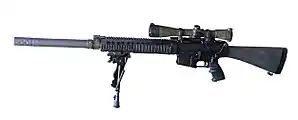Eugene Stoner
Eugene Morrison Stoner (November 22, 1922 – April 24, 1997) was an American firearms designer who is most associated with the development of the ArmaLite AR-15 rifle that was modified by the US military as the M16 rifle.
Eugene Stoner | |
|---|---|
 | |
| Born | November 22, 1922 |
| Died | April 24, 1997 (aged 74) |
| Occupation | Engineer |
| Engineering career | |
| Significant design | AR-15 and other small arms |
Early life
The son of Lloyd Lester Stoner and Billie Morrison,[1] Stoner attended high school in Long Beach and upon graduation worked for the Vega Aircraft Company installing armament.
During World War II, he enlisted for Aviation Ordnance in the U.S. Marine Corps and served in the South Pacific and northern China.
Engineer
In late 1945 Stoner began working in the machine shop for Whittaker, an aircraft equipment company, and ultimately became a Design Engineer.
In 1954 he came to work as chief engineer for ArmaLite, a division of Fairchild Engine & Airplane Corporation. While at ArmaLite, he designed a series of prototype small arms, including the AR-3, AR-9, AR-11, AR-12, none of which saw significant production. Their only real success during this period was the AR-5 survival rifle, which was adopted by the United States Air Force.[2]

In 1955, Stoner completed initial design work on the revolutionary ArmaLite AR-10, a lightweight (7.25 lbs.) select-fire infantry rifle in 7.62×51mm NATO caliber. The AR-10 was submitted for rifle evaluation trials to the US Army's Aberdeen Proving Ground late in 1956. In comparison with competing rifle designs previously submitted for evaluation, the AR-10 was smaller, easier to fire in automatic, and much lighter. However it arrived very late in the testing cycle, and the army rejected the AR-10 in favor of the more conventional T44, which became the M14. The AR-10's design was later licensed to the Dutch firm of Artillerie Inrichtingen, who produced the AR-10 until 1960 for sale to various military forces.[3]


At the request of the U.S. military, Stoner's chief assistant, Robert Fremont along with Jim Sullivan designed the Armalite AR-15 from the basic AR-10 model, scaling it down to fire the small-caliber .223 Remington cartridge, slightly enlarged to meet the minimum Army penetration requirements. The AR-15 was later adopted by United States military forces as the M16 rifle.[3][4]
After ArmaLite sold the rights to the AR-15 to the Colt Firearms Company, Stoner turned his attention to the AR-16 design. This was another advanced 7.62 mm rifle but used a more conventional piston and a number of stamped parts to reduce cost. This weapon saw only prototype development but adaptation to .223 resulted in the somewhat successful and often imitated Armalite AR-18.[3]

Stoner left ArmaLite in 1961 to serve as a consultant for Colt. He eventually accepted a position with Cadillac Gage where he designed the Stoner 63 Weapons System.[3] This was a modular weapons system which could be reconfigured to be a standard automatic rifle, a light machine gun, a medium machine gun, or a solenoid-fired fixed machine gun.
The Stoner Weapons System used a piston-operated gas impingement system patented as US PAT No. 2,951,424 and granted in September 1960. Once again, Robert Fremont and Jim Sullivan took a Stoner rifle and redesigned it for the .223 Remington cartridge, to create the Stoner 63 Weapons System.[5]
Stoner then worked with TRW by designing the TRW 6425 25 mm Bushmaster auto cannon, which was later manufactured by Oerlikon as the KBA.[2]
He co-founded ARES Incorporated of Port Clinton, Ohio, in 1972, but left the company in 1989, after designing the Ares Light Machine Gun, sometimes known as the Stoner 86. It was an evolved version of the Stoner 63. At Ares, he also designed the Future Assault Rifle Concept (FARC).[2]

In 1990, he joined Knight's Armament Company (KAC) to create the Stoner Rifle-25 (SR-25), which currently sees military service as the United States Navy Mark 11 Mod 0 Sniper Weapon System. While at KAC, he also worked on yet another version of the Stoner Weapons System, called the Stoner 96. Among his last designs were the SR-50 rifle and the Colt 2000.[6]
Mikhail T. Kalashnikov

On May 16, 1990, Eugene M. Stoner and Mikhail T. Kalashnikov would meet for the first time. They would spend the next few days talking, sharing stories, shopping, going out to dinner and touring Washington D.C. They visited the Smithsonian Institution, the NRA’s National Firearms Museum, and a hunting lodge owned by the gun club at Star Tannery, where they went shooting. They would also visit the Marine Corps base in Quantico, Virginia, where they watched new weapons being tested. During this short visit both men, intimately familiar with the other's work, shared a common bond and became friends, "not needing an interpreter to get their thoughts across." [7]
Death
Eugene Stoner died as a result of cancer at the age of 74 on April 24, 1997, and was later interred in the Quantico National Cemetery, Quantico, Virginia.
He was survived by his wife, Barbara Hitt Stoner, whom he married in 1965; his first wife, Jean Stoner Mahony of Newport Beach, California, from whom he was divorced in 1962; four children from his first marriage, seven grandchildren and four great-grandchildren.
Weapon designs
Other designs
- Stoner 62 / Stoner 63
- TRW 6425 25 mm "Bushmaster" auto cannon
- Oerlikon KBA 25 mm auto cannon (evolution of TRW 6425)
- ARES FMG (Folding Machine Gun)
- Ares Light Machine Gun (A.K.A. the "Stoner 86")
- Advanced Individual Weapon System (AIWS)
- Future Assault Rifle Concept (FARC)
- SR-25 (U.S. Navy Mark 11 Mod 0 Sniper Rifle)
- SR-15
- Mk 12 Special Purpose Rifle
- Stoner 96
- SR-50
References
- "Eugene Stoner". GENi.
- Rottman, Gordon (2011). The M16. Osprey Publishing. p. 9. ISBN 978-1-84908-690-5. Retrieved 29 July 2013.
- Chivers, C. J. (2010). The Gun. New York: Simon and Schuster. pp. 292–295. ISBN 978-0-7432-7076-2.
- Cutshaw, Charles Q. (2011). "Assault Rifles". Tactical Small Arms of the 21st Century: A Complete Guide to Small Arms From Around the World. Iola, Wisconsin: Gun Digest Books. p. 235. ISBN 978-1-4402-2482-9. Retrieved 29 July 2013.
- Johnston, Gary Paul (2006). "New from DPMS A 308 That Delivers the Goods". Soldier of Fortune. Boulder, Colorado: Omega Group, Limited. 31: 24. Retrieved 29 July 2013.
- Lewis, Jack (1 January 2004). "Colt's All american 2000". The Gun Digest Book of Assault Weapons. Iola, Wisconsin: Krause Publications Craft. p. 49. ISBN 978-0-87349-658-2. Retrieved 29 July 2013.
- "Kalashnikov and His Gun Visit America". Erenow.
External links
| Wikimedia Commons has media related to Eugene Stoner. |
| Wikiquote has quotations related to: Eugene Stoner |